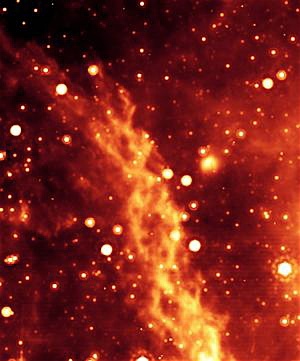Unprecedented Double Helix Nebula Near Center Of The Milky Way
Astronomers report an unprecedented elongated
double helix nebula near the center of our Milky Way galaxy, using observations
from NASA's Spitzer Space Telescope.

Astronomers report an unprecedented elongated double helix nebula near the center of our Milky Way galaxy, using observations from NASA’s Spitzer Space Telescope. The part of the nebula the astronomers observed stretches 80 light years in length. The research is published March 16 in the journal Nature.
“We see two intertwining strands wrapped around each other as in a DNA molecule,” said Mark Morris, a UCLA professor of physics and astronomy, and lead author. “Nobody has ever seen anything like that before in the cosmic realm. Most nebulae are either spiral galaxies full of stars or formless amorphous conglomerations of dust and gas — space weather. What we see indicates a high degree of order.”
The double helix nebula is approximately 300 light years from the enormous black hole at the center of the Milky Way. (The Earth is more than 25,000 light years from the black hole at the galactic center.)
This magnetic field is strong enough to cause activity that does not occur elsewhere in the galaxy; the magnetic energy near the galactic center is capable of altering the activity of our galactic nucleus and by analogy the nuclei of many galaxies, including quasars, which are among the most luminous objects in the universe. All galaxies that have a well-concentrated galactic center may also have a strong magnetic field at their center, Morris said, but so far, ours is the only galaxy where the view is good enough to study it.
What launches the wave, twisting the magnetic field lines near the center of the Milky Way? Morris thinks the answer is not the monstrous black hole at the galactic center, at least not directly.
Orbiting the black hole like the rings of Saturn, several light years away, is a massive disk of gas called the circumnuclear disk; Morris hypothesizes that the magnetic field lines are anchored in this disk. The disk orbits the black hole approximately once every 10,000 years.
“Once every 10,000 years is exactly what we need to explain the twisting of the magnetic field lines that we see in the double helix nebula,” Morris said.
Look at this series of quandries! Here we have astronomers and astrophysicists physically limited by the state of motive and observational technology. Yet, with computational analysis and technology removed from our Stone Age past by just a millisecond or two of geological time — we can analyze and hypothesize about systems contained “merely” within our galaxy.
To be around just 50 or 100 years from now would be a delight. Contemplate 1,000 or 10,000 years of advances!
Posted: Sun - March 19, 2006 at 05:34 AM